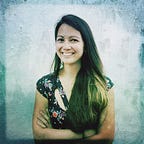 Daniella Zalcman was horrified when last year’s World Press Photo’s State of the Industry Report confirmed that only 15 percent of photojournalists are women. “It just felt so disheartening,” said Zalcman, who is a photojournalist herself, “not only from a hiring equality standpoint, but from believing that journalism can only cover diverse communities respectfully and responsibly if the journalists themselves come from diverse backgrounds.” Instead of complaining, she decided to do something about it and started Women Photograph this year, a platform to elevate the voices of female and non-binary visual journalists.
Daniella Zalcman was horrified when last year’s World Press Photo’s State of the Industry Report confirmed that only 15 percent of photojournalists are women. “It just felt so disheartening,” said Zalcman, who is a photojournalist herself, “not only from a hiring equality standpoint, but from believing that journalism can only cover diverse communities respectfully and responsibly if the journalists themselves come from diverse backgrounds.” Instead of complaining, she decided to do something about it and started Women Photograph this year, a platform to elevate the voices of female and non-binary visual journalists.
This week, BRIGHT Magazine is partnering with Women Photograph to spotlight four female photographers covering calamities around the world. To kick it off, Zalcman muses on her vision for this initiative.
BRIGHT Magazine: Why did you start Women Photograph?
Daniella Zalcman: Whenever I tried to question hiring practices within the editorial community, the responses I heard were either “I don’t know where to find women,” or “I don’t think about gender when I hire.” I couldn’t do anything immediate about the latter, but I knew I could render the former excuse invalid by creating a hiring resource for photo editors who wanted to be more intentional with their assigning.
BRIGHT: Why is it important for women to cover calamity?
DZ: It’s important for women to cover every genre of news. I hate making gendered generalizations, but on average I think that where men gravitate towards conflict and hard news, women tend to prefer the periphery of violence — in quieter contexts where they can create more intimate connections with people. That obviously isn’t always true — there are remarkable female conflict photographers and male social documentary photographers — but I think those are often the stories women are most attracted to.
One of many problems with the current imbalance in our industry is that when we predominantly present news through the male gaze, we codify and reinforce that perspective. It’s important for society that we spend just as much time seeing our world through a female perspective, particularly calamity.
BRIGHT: How if at all do recent events, including #MeToo and the increasing number of sexual assault allegations against powerful men, relate to photojournalism?
DZ: They all connect back to this idea that, in countless ways, we have traditionally silenced women’s voices. When we allow an overwhelming percentage of our chief visual storytellers to be men, we’re saying that female storytellers and their perspectives don’t matter — that women’s voices in general don’t matter.
It’s very much connected to the larger machinations of how our societies at large continue to perpetuate misogyny and allow for the incidents referenced by #MeToo to continue.
BRIGHT: Tell us a bit about why you selected the photographers you did for this upcoming week. What sets their work apart and why was it relevant for the Calamity Issue?
DZ: These are four photographers who have all created long-term bodies of work on calamity — from civil unrest to environmental disaster to violence against women. Their approaches are all wildly different — Smita Sharma and Hannah Reyes Morales are working in their home countries; Natalie Keyssar and Nichole Sobecki are outsiders. Keyssar’s work in Venezuela is often a poetic, allegorical way of looking at calamity, whereas Sharma’s is intensely personal and confrontational. But the thing that ties them all together is the time and devotion they’ve brought to each story.
BRIGHT: There’s a lot of work to be done to address these industry problems. Why was forming Women Photograph the path you chose?
DZ: I like to think about things from a solutions-oriented perspective and the most immediate strategy that I could think of was to create a hiring resource for photo editors. After that, I saw a lack of basic infrastructure and support for young female photojournalists, so I created a mentorship program and project grants for young photographers. If the system is broken, or missing crucial resources for a particular community of photojournalists, I want to fix it.
BRIGHT: Any glimmers of hope? Are there people or institutions making a significant dent on this problem?
DZ: I think we’re seeing a lot of positive movement and change right now. I’m impatient and overly demanding so it never feels like enough, but I do think we’ve witnessed a monumental shift in the past year. People are starting to listen to women and consider how diverse perspectives impact responsible journalism. I think it’s hard to measure meaningful change now — it’s largely anecdotal at this point — but I do know that more and more people in this industry are having meaningful conversations about why intentional hiring and diversity matter.
BRIGHT: Women Photograph recently had an exhibit at PHOTOVILLE, a New York City photography festival, called Insider/Outsider, where you asked photographers how they identified. Do you identify as an insider or an outsider in the communities where you photograph? Why was this question important to you?
DZ: I’m exclusively an outsider in the long-term documentary projects I work on — at the moment primarily in Indigenous communities impacted by coercive assimilation policies. But I also believe that photojournalism as it exists now is a deeply colonial practice‚ predicated on the belief that we in the west are somehow more equipped to tell the stories of people elsewhere in the world than they are themselves. That’s not true. So I often feel very uncomfortable in my role as a photojournalist in the spaces where I spend most of my time.
As a result, I’m trying hard to figure out how to be as collaborative and open as possible with my projects and the people who give me access to their lives and their stories. That being said, I also think that journalism at its best involves a mix of insider and outsider perspectives — we see things differently as locals and as aliens, and that balance creates healthy tension in how we’re able to interpret ourselves and others.
